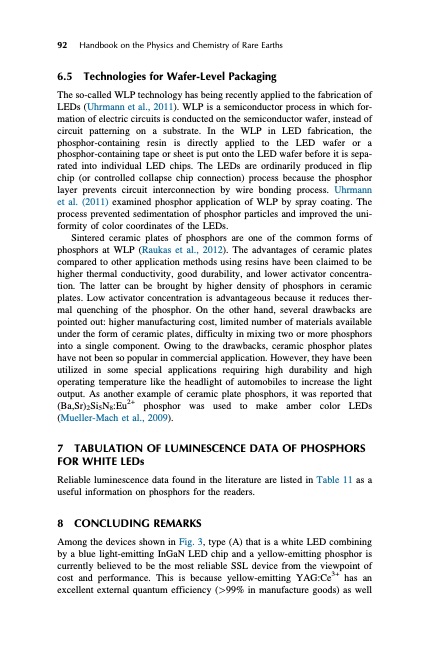
PDF Publication Title:
Text from PDF Page: 128
92 Handbook on the Physics and Chemistry of Rare Earths 6.5 Technologies for Wafer-Level Packaging The so-called WLP technology has being recently applied to the fabrication of LEDs (Uhrmann et al., 2011). WLP is a semiconductor process in which for- mation of electric circuits is conducted on the semiconductor wafer, instead of circuit patterning on a substrate. In the WLP in LED fabrication, the phosphor-containing resin is directly applied to the LED wafer or a phosphor-containing tape or sheet is put onto the LED wafer before it is sepa- rated into individual LED chips. The LEDs are ordinarily produced in flip chip (or controlled collapse chip connection) process because the phosphor layer prevents circuit interconnection by wire bonding process. Uhrmann et al. (2011) examined phosphor application of WLP by spray coating. The process prevented sedimentation of phosphor particles and improved the uni- formity of color coordinates of the LEDs. Sintered ceramic plates of phosphors are one of the common forms of phosphors at WLP (Raukas et al., 2012). The advantages of ceramic plates compared to other application methods using resins have been claimed to be higher thermal conductivity, good durability, and lower activator concentra- tion. The latter can be brought by higher density of phosphors in ceramic plates. Low activator concentration is advantageous because it reduces ther- mal quenching of the phosphor. On the other hand, several drawbacks are pointed out: higher manufacturing cost, limited number of materials available under the form of ceramic plates, difficulty in mixing two or more phosphors into a single component. Owing to the drawbacks, ceramic phosphor plates have not been so popular in commercial application. However, they have been utilized in some special applications requiring high durability and high operating temperature like the headlight of automobiles to increase the light output. As another example of ceramic plate phosphors, it was reported that (Ba,Sr)2Si5N8:Eu2+ phosphor was used to make amber color LEDs (Mueller-Mach et al., 2009). 7 TABULATION OF LUMINESCENCE DATA OF PHOSPHORS FOR WHITE LEDs Reliable luminescence data found in the literature are listed in Table 11 as a useful information on phosphors for the readers. 8 CONCLUDING REMARKS Among the devices shown in Fig. 3, type (A) that is a white LED combining by a blue light-emitting InGaN LED chip and a yellow-emitting phosphor is currently believed to be the most reliable SSL device from the viewpoint of cost and performance. This is because yellow-emitting YAG:Ce3+ has an excellent external quantum efficiency (>99% in manufacture goods) as wellPDF Image | HANDBOOK ON THE PHYSICS AND CHEMISTRY OF RARE EARTHS

PDF Search Title:
HANDBOOK ON THE PHYSICS AND CHEMISTRY OF RARE EARTHSOriginal File Name Searched:
Chemistry-Rare-Earths-49.pdfDIY PDF Search: Google It | Yahoo | Bing
Sulfur Deposition on Carbon Nanofibers using Supercritical CO2 Sulfur Deposition on Carbon Nanofibers using Supercritical CO2. Gamma sulfur also known as mother of pearl sulfur and nacreous sulfur... More Info
CO2 Organic Rankine Cycle Experimenter Platform The supercritical CO2 phase change system is both a heat pump and organic rankine cycle which can be used for those purposes and as a supercritical extractor for advanced subcritical and supercritical extraction technology. Uses include producing nanoparticles, precious metal CO2 extraction, lithium battery recycling, and other applications... More Info
| CONTACT TEL: 608-238-6001 Email: greg@infinityturbine.com | RSS | AMP |